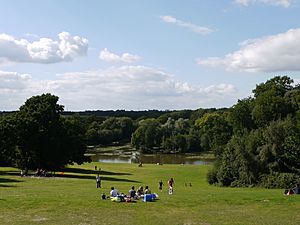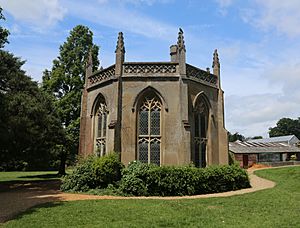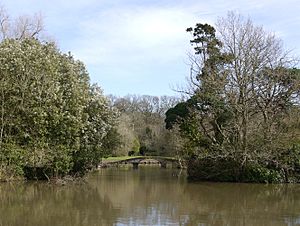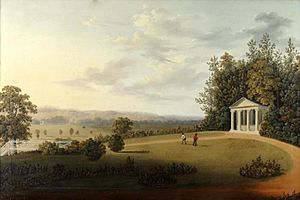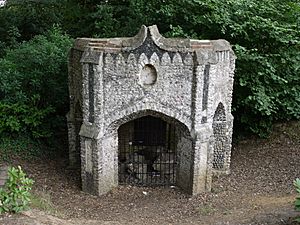Staunton Country Park facts for kids
Staunton Country Park is a huge park and forest in Hampshire, England. It covers about 1,000 acres (4 km²)! This beautiful park was designed in the Regency style, which was a popular time for gardens and architecture in the early 1800s.
Inside the park, you can find a special farm, a lovely lake, interesting follies (buildings built just for decoration), a fun maze, a walled garden, and glasshouses filled with plants. It's free to enter the park itself. However, there's also a visitor centre with animals and other attractions that you need to pay to visit.
Staunton Country Park is located between Leigh Park and Rowland's Castle, close to the town of Havant.
Contents
History of Staunton Country Park
The first gardens at this site were started in 1802 by a man named William Garrett. He bought the land and began creating the beautiful park we see today.
In 1820, a famous Regency politician and plant expert, Sir George Thomas Staunton, bought the park. He made many big changes and additions. He built the large lake and added several follies, which are decorative buildings.
When Sir George Staunton passed away in 1859, his cousin, Henry Cormick Lynch, inherited the park. Sadly, Henry Lynch died just six weeks later. The park then went to his son, George Staunton Lynch. He changed his name to George Staunton Lynch-Staunton.
In 1861, George Staunton Lynch-Staunton sold the park to William Henry Stone. Stone built a brand new house in the park, which was finished in 1865. Most of the old house was taken down around that time.
The park changed hands a few more times. In 1875, Stone sold it to Frederick Fitzwygram. After he died in 1904, his son, Frederick Loftus Fitzwygram, took over. When he died in 1920, his sister, Angela Fitzwygram, inherited it.
Finally, in June 1944, the city of Portsmouth bought the estate and gardens. In 1950, the gardens were given to the parks committee. Staunton Country Park officially became a Country park in 1987, meaning it's a place for everyone to enjoy nature.
William Henry Stone's house was taken down in 1959. However, the Gothic Library, which was part of Garrett's original house, is still standing today.
Since 2012, Staunton Country Park has hosted Havant parkrun, a weekly running event. In 2017, the park received special funding to fix up its old follies and build a new visitor centre in the park's old Coach House.
Leigh Water: The Park's Lake
The park is home to a large lake called Leigh Water. Before the lake was built, there was only a small pond. The main construction of the lake happened between 1828 and 1836.
In 1830, a three-arched bridge, known as the Chinese bridge, was built. A few years later, in 1832, two more buildings were added: a boathouse designed in a Chinese style and a Pergola (a garden archway). An ornamental Kiosk with an onion dome and small Minarets was added by the lakeside in 1832 or 1834. In 1835, a Chinese-themed summer house was also built near the lake.
The lake has several islands. The biggest island used to have a cottage on it. A smaller island, called Fort Island, originally had a small battery with nine guns. The flag of the Qing Dynasty (an old Chinese empire) was flown on Fort Island. The cottage on the largest island was where the under-gardener lived. His job was to look after the lake area. A third island was called Swan Island, and as its name suggests, it was home to swans.
When Henry Stone owned the park, the lake was made even bigger, and an extra island was added. He also had the cottage taken down and replaced it with an American-style garden. Most of the buildings around the lake were removed at this time, though some were replaced with new ones. The Chinese bridge stayed, but its look was changed a bit.
Follies: Decorative Buildings
Staunton Country Park originally had many follies, which are buildings built just for fun or decoration. Some of these unique structures are still standing today.
The Temple
The Temple was a special memorial built by George Staunton in 1824. It had a large memorial urn in the middle. At first, the Temple had dedications to Staunton's parents and other family and friends. Over the next few years, eight busts (sculptures of heads and shoulders) were added around the urn. Most of these busts were of Staunton's friends who had passed away. One bust was of William Howley, who was still alive at the time.
In 1840, Staunton decided not to add any more memorials to the Temple. However, more busts were added later, mostly of people who were still living. The Temple was eventually removed when William Henry Stone built his new house on its site.
The Shell House
The Shell House was built in 1828. It is covered in shells collected from Hayling Island, a nearby area. This building has six sides and was designed to look like the Chichester Cross, a famous market cross.
By 1836, George Staunton was using the Shell House as a museum of curiosities. He kept interesting items there, like a stuffed crocodile and pieces of Roman pottery. Today, the arches of the Shell House have permanent barriers to prevent people from going inside. It is a Grade II* listed building, which means it's a very important historical building.
The Election Column
The Election Column was put up in 1837. It first showed the date of Staunton's only election victory and two defeats. A year later, the date he was elected as a Member of Parliament (MP) for Portsmouth was added. The column was removed at some point when Stone owned the park. The inscription about Staunton's election wins was moved to the Shell House.
The Beacon
The Beacon is another folly built in 1830. It was designed by Lewis Vulliamy to look like an Ionic temple. Much of it was built using materials from a house that had been taken down nearby. The roof has a hole in it, which was made for a flagpole. The roof is domed and held up by eight Doric columns.
The Moss House
The Moss House was likely built in the early 1830s and had a covered seat inside. The interior was lined with soft moss, and the floor was made of different colored pebbles from Emsworth. This charming little house was removed in the 1860s during the building work done by William Henry Stone.
The Canning Obelisk
The Obelisk was another design by Lewis Vulliamy. Its construction began in August 1832. This tall, pointed monument has a dedication to George Canning, a famous politician. By 1986, the Obelisk was in very poor condition.


